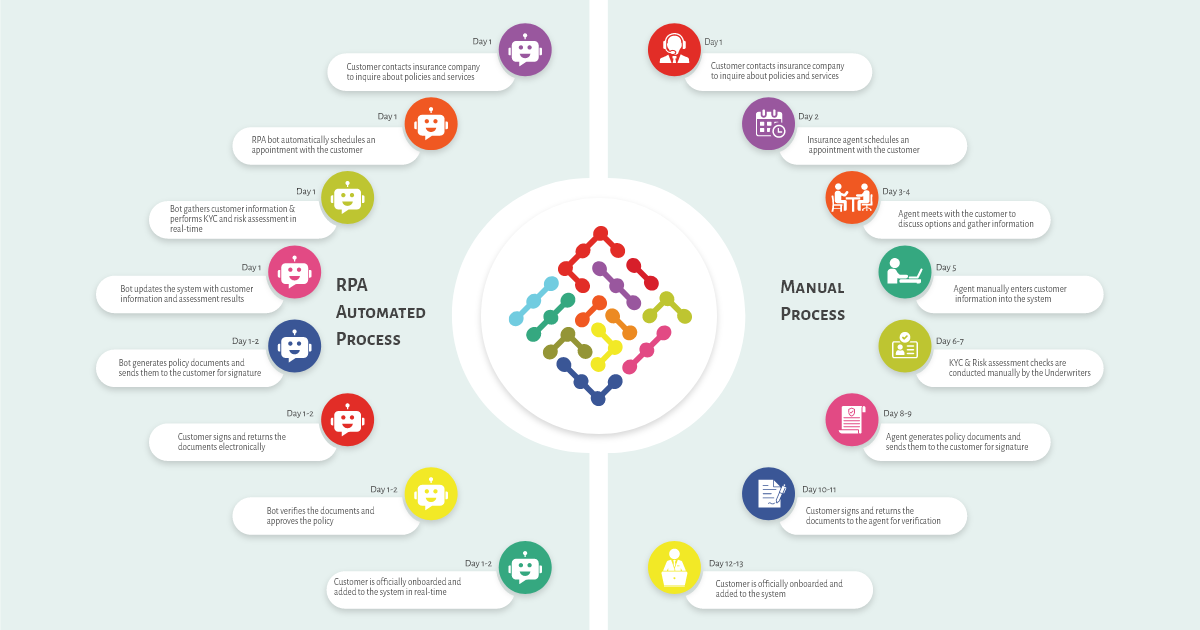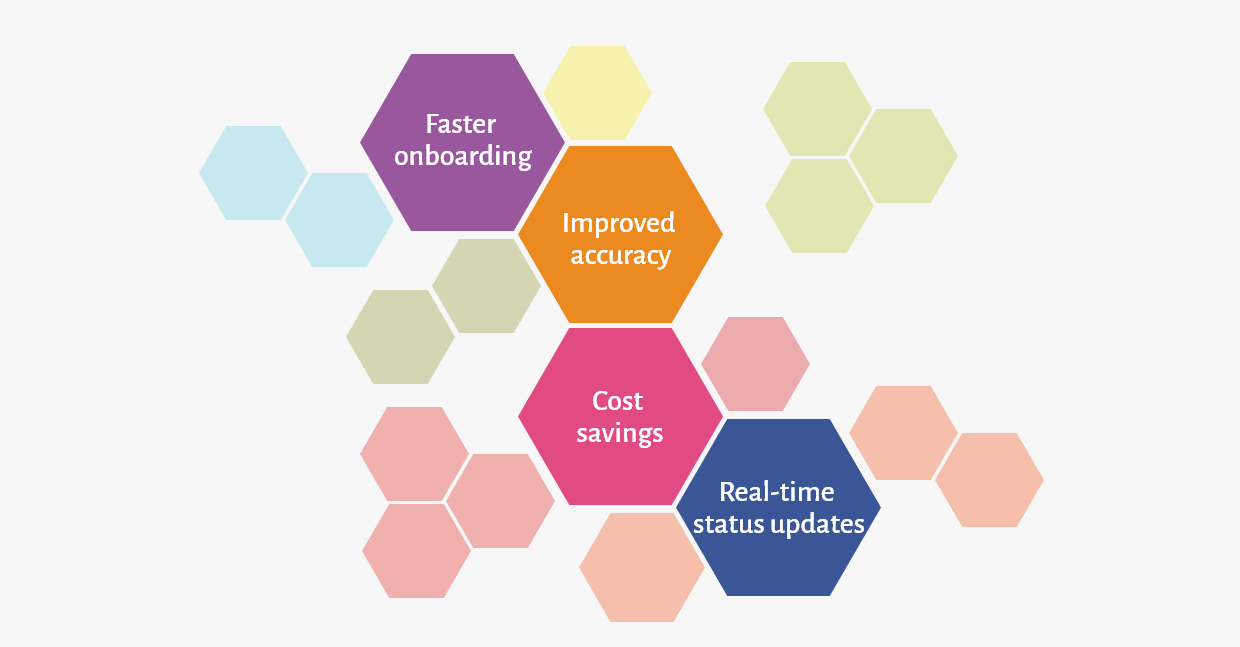Talosnation
Customer onboarding is a critical procedure in the insurance sector that lays the groundwork for a long-term connection between the insurer and the consumer. The process of introducing new customers to an insurer's policies, services, and processes is known as "customer onboarding." The onboarding process's goal is to provide a great customer experience, encourage client loyalty, and foster trust between the consumer and the insurer.
Yet, due to the sheer volume of information and documents required, the onboarding process in the insurance business can be difficult. Moreover, the procedure is often laborious, time-consuming, and error-prone. Manual processes not only cause delays in the onboarding process, but they can also result in a negative customer experience, which can have an influence on customer retention.
Here is where Robotic Process Automation (RPA) technology may help expedite customer onboarding in the insurance sector. RPA technology automates time-consuming and repetitive processes in the onboarding process, such as data entry, form filling, and policy issuance. Insurance businesses may increase the speed and accuracy of their onboarding process while lowering expenses and boosting client happiness by automating these operations.
We will go more into the subject of RPA technology and its potential to expedite customer onboarding in the insurance business in the following sections. We will look at the advantages of using RPA technology, the stages involved in doing so, real-world examples of firms that have done so, and best practices for effective deployment. We will also look at potential obstacles and how to overcome them. Lastly, we will investigate the future of RPA technology in the insurance industry's customer onboarding.
But what is RPA?
Robotic Process Automation (RPA) is a new technology with the potential to transform company processes in a variety of sectors, including insurance. RPA is a software technique that mimics human activities to automate repetitive, rule-based, and time-consuming processes. RPA technology, in a nutshell, is intended to automate repetitive processes that are traditionally handled by people.
RPA employs bots, or software robots, that are designed to do certain tasks. These bots can be programmed to do a variety of functions, such as data entry, form filling, report generation, and policy issuance. RPA technology can be deployed to automate a variety of insurance business operations, such as customer onboarding, claims processing, policy administration, and underwriting.
RPA technology has the potential to increase the efficiency and accuracy of business operations while lowering expenses. RPA bots operate around the clock and may do jobs quicker and more precisely than humans. Insurance firms may benefit from shorter turnaround times, fewer mistakes, and cost savings as an outcome of all this.
Another advantage of RPA technology is its ease of integration with current systems and procedures. RPA bots may be created to interact with a broad variety of systems and applications, including legacy systems, without needing significant modifications to the current IT infrastructure.
RPA technology is also scalable and versatile, which means it can be rapidly and easily implemented to automate specific processes as and when they are required. This makes it an excellent choice for insurance businesses seeking to automate certain procedures or operations.
Overall, RPA technology has the potential to alter the way insurance firms function, allowing them to increase the efficiency, accuracy, and speed of their operations while lowering costs and improving the customer experience. In the next part, we will look at how RPA may be utilized to improve customer onboarding in the insurance business.

In the insurance industry, the customer onboarding process consists of many processes that necessitate the gathering, verification, and processing of personal information. Data input, compliance checks, risk assessment, document processing, and customer communication are among the stages involved. The procedure can be complicated and time-consuming, involving numerous departments such as underwriting, claims, and customer support.
RPA technology, which uses software robots to do repetitive and time-consuming operations, can automate the customer onboarding process in insurance. RPA is capable of entering and verifying customer data, doing regulatory checks, assessing risk, processing documents, and sending automated emails and notifications to customers. To deliver a smooth onboarding experience, RPA may also interact with other systems such as customer relationship management (CRM) and enterprise resource planning (ERP).
RPA can automate various processes in the insurance customer onboarding process, including:
- Data entry and verification: RPA can extract customer data from numerous sources and enter it into appropriate systems like CRM and ERP.
- Compliance checks: RPA can run regulatory checks to guarantee that all client information complies with compliance regulations such as Know Your Customer (KYC) and Anti-Money Laundering (AML).
- Risk assessment: RPA can evaluate client data such as driving records, credit ratings, and medical histories to assess the risk associated with a certain policy and determine a suitable premium rate.
- Document processing: RPA can evaluate client papers such as driver's licenses, passports, and insurance policies, extract important information, and update applicable systems automatically.
- Client communication: RPA can send automatic emails and alerts to customers, informing them of the progress of their onboarding process and answering common questions.
RPA can dramatically enhance the speed and quality of customer onboarding in insurance by automating these operations, minimizing errors and delays.
Finally, RPA technology can help speed up the customer onboarding process in insurance by automating repetitive and time-consuming operations, giving real-time status updates, and boosting communication across departments. Insurance businesses that use RPA in client onboarding can deliver faster and more accurate onboarding, resulting in higher customer satisfaction and lower expenses. But, before deploying RPA, insurance businesses must think about things like data security, regulatory compliance, and staff training. The benefits of applying RPA to client onboarding for insurance businesses will be discussed in the next section.

Using RPA technology in customer onboarding can provide insurance firms with various benefits, including:
- Faster onboarding: Many tasks within the client onboarding process, such as data entry and verification, compliance checks, risk assessment, and document processing, can be automated using RPA. RPA can drastically reduce the time required to complete the onboarding process by automating these operations, resulting in quicker client onboarding. This can enhance the client experience while also lowering the risk of losing potential consumers.
- Improved accuracy: Manual data entry might result in inaccuracies and erroneous customer data. RPA can reduce mistakes caused by manual data entry, enhancing customer data accuracy. This can lead to better risk assessment, less fraud, and improved underwriting accuracy.
- Cost savings: RPA has the potential to drastically decrease the time and resources necessary for client onboarding, resulting in cost savings for insurance companies. RPA can improve productivity and efficiency by automating repetitive tasks, allowing people to focus on more complicated tasks. This may eliminate the need for additional staff, resulting in substantial cost savings.
- Real-time status updates: RPA can give real-time status updates on client onboarding processes, enhancing communication across departments and delivering transparency to consumers. This can result in increased customer satisfaction, which improves the likelihood of client retention.
Therefore, utilizing RPA in client onboarding can enhance the efficiency and productivity of client onboarding by automating repetitive operations, resulting in a better customer experience and increased revenue for insurance firms. Let's move on to the use cases of RPA in customer onboarding for insurance in the next section.
Numerous insurance businesses have already implemented RPA technology for their customer onboarding operations, and the results have been tremendous. Here are some real-world examples of how RPA is being utilized in insurance customer onboarding:

- Anthem, a prominent health insurance corporation located in the United States, used RPA to automate the verification of new client data from numerous sources. RPA bots examine consumer data across several systems and indicate any inconsistencies for further investigation. As a consequence, the firm has been able to increase the accuracy of its client data while cutting onboarding new customers by up to 50%.
- Allianz, a multinational insurance company, employed RPA to automate claims processing during customer onboarding. RPA bots may automatically check claims, process payments, and offer progress updates to clients, decreasing the need for user interaction. This has enabled the organization to cut the time it takes to process claims from weeks to just a few days, resulting in quick reimbursements and improved customer satisfaction.
- Zurich Insurance Group, a European insurer, used RPA technology to automate the onboarding process for its corporate customers. The organization was able to speed up the onboarding process while assuring data accuracy by automating data entry. This resulted in fewer administrative errors, greater efficiency, and a better customer experience.
- AXA, a multinational insurance company, successfully implemented RPA in customer onboarding processes, including validating customer information and processing applications. This resulted in improved accuracy, increased efficiency, reduced processing time, and cost savings. For instance, RPA technology reduced the risk of human error, ensured accurate customer data, and faster processing. The implementation also allowed employees to focus on complex tasks and resulted in cost savings by automating onboarding processes.
Overall, these use cases illustrate how RPA can be used for numerous activities and procedures within insurance client onboarding, resulting in quicker onboarding times, higher accuracy, and better customer experiences. In the next part, we'll go over some of the potential issues that insurance firms can experience while deploying RPA for client onboarding, as well as solutions to those challenges.

While RPA technology has several advantages for insurance firms, deploying it for customer onboarding may be difficult. One of the most significant hurdles is the requirement for competence in RPA deployment, which necessitates specific skills and knowledge.
Another problem is ensuring consumer data confidentiality and privacy during the onboarding process. Insurance businesses must verify that their RPA deployment conforms to data privacy and security standards and best practices.
In addition, integrating RPA technology with current systems and processes can be difficult since it may necessitate modifications to the company's IT infrastructure and business operations.
To overcome these obstacles, insurance firms could consider working with experienced RPA providers or investing in RPA implementation training for their existing workers from TalosNation. Before using RPA technology, they should undergo rigorous risk assessments and compliance checks.
Thus, while there are hurdles to deploying RPA technology for client onboarding in the insurance business, these issues may be addressed with good planning and preparation to yield considerable advantages for the firm and its consumers. Read on to learn about the best practices for deploying RPA in insurance customer onboarding.
While deploying RPA technology during client onboarding can provide several benefits, best practices must be followed to guarantee a successful deployment. Here are some recommended practices for insurance businesses considering RPA technology for their customer onboarding process:
- Process identification and prioritization: Prior to deploying RPA, identify and prioritize the processes that can be automated. Begin with repetitive, manual, and time-consuming activities.
- Choose the best RPA tool: Choose an RPA solution that meets your organization's demands, criteria, and budget.
- Create a roadmap: that specifies the implementation plan, dates, and milestones. Participate in the process with all stakeholders.
- Do a pilot test: Before using RPA across the business, run a small-group pilot test to detect any possible concerns and modify the deployment strategy.
- Give proper training: Ensure that staff who will be working with RPA have the essential skills and expertise to operate and maintain the system.
- Monitor & Evaluate: Monitor and review the RPA installation on a regular basis to discover any difficulties and verify the technology is achieving the intended benefits.
While deploying RPA technology for customer onboarding, insurance firms should additionally consider the following factors:
- Scalability: To manage the rising volume of client onboarding requests, the RPA system should be scalable.
- Data privacy: Because insurance firms handle sensitive consumer data, it is critical that RPA technology adheres to data privacy rules.
- Change management: RPA installation will need a change in existing processes, which must be managed successfully.
- Cost: Insurance firms should carefully consider the cost of RPA installation as well as the potential ROI.
Sticking to these best practices" will assist insurance businesses in effectively implementing RPA technology in client onboarding, resulting in faster onboarding, increased accuracy, and cost savings. Continue reading to find out about the future of RPA technology in client onboarding for insurance firms.
The future of RPA in client onboarding for insurance seems bright, with several technological breakthroughs currently in the works. Since insurance firms continue to confront client onboarding issues, RPA offers a solution that streamlines the process and cuts expenses.
The integration of machine learning (ML) and artificial intelligence (AI) with RPA to improve the technology's capabilities is one trend that is anticipated to develop in the future. RPA will be able to do more than just automate repetitive jobs; it will also be able to make intelligent judgments based on the data it processes.
Chatbots and virtual assistants are another area where RPA is expected to have an influence in the future. These solutions may be used with RPA to deliver a more smooth and personalized onboarding experience for consumers.
RPA technology is likely to become more accessible and economical for small and midsized insurance organizations as it matures. These enterprises will be able to compete with larger firms by providing faster and more effective client onboarding procedures.
Altogether, the future of RPA in insurance client onboarding is bright, with the potential to alter the way insurance businesses onboard new customers. As technology continues to improve and advance, we can expect to see even more inventive solutions in the coming years.
Lastly, RPA technology has the ability to dramatically speed and enhance the customer onboarding process in the insurance business. RPA may help insurance firms achieve faster onboarding, increased accuracy, and cost savings by automating manual and repetitive operations.
Using RPA technology in client onboarding may be a difficult process, and insurers must carefully analyze the procedures involved as well as the possible problems. RPA, on the other hand, may deliver several benefits to insurance firms and improve the entire client experience with good design and implementation.
As the insurance industry evolves and adapts to changing customer expectations, RPA technology is anticipated to play an increasingly crucial role in customer onboarding. Businesses that invest in RPA technology and stay ahead of the curve will be better positioned to compete in the insurance industry.
Overall, RPA technology offers insurance businesses great potential to streamline their operations and improve client satisfaction. Insurance firms may improve their client onboarding process, gain higher productivity, and ultimately provide better value to their consumers by using the benefits of RPA.
If you're interested in learning more about how RPA can help your insurance company streamline its customer onboarding process, TalosNation is here to help. Our team of experts can guide you through the implementation process and help you leverage the full potential of RPA technology. Contact us today to learn more about the benefits of RPA for insurance customer onboarding.
